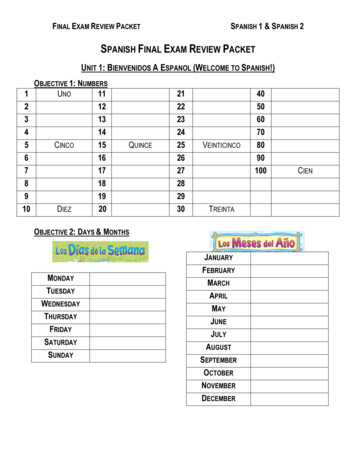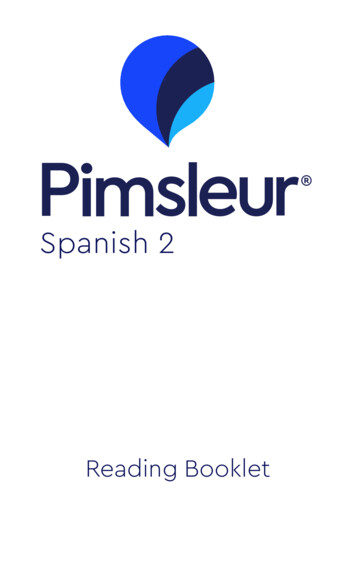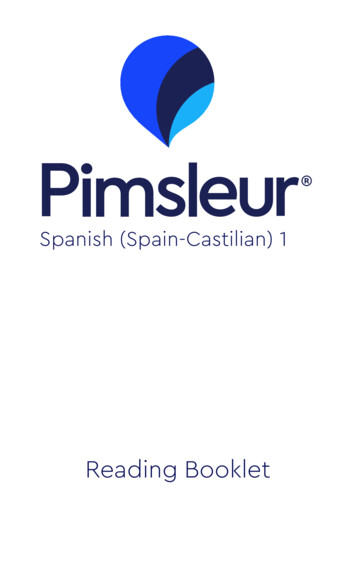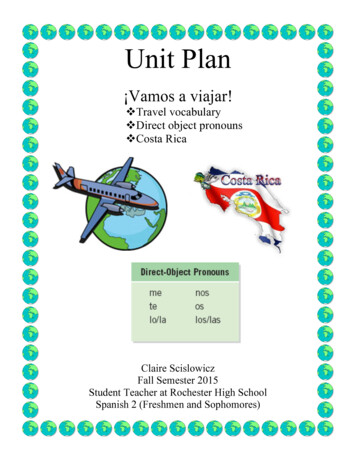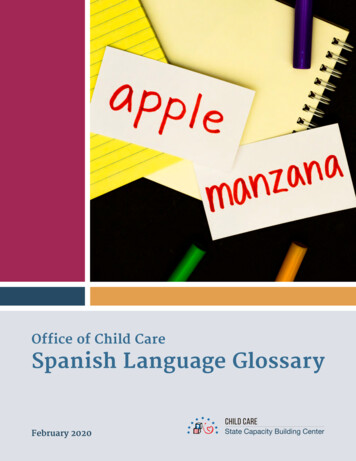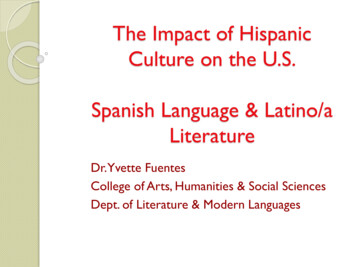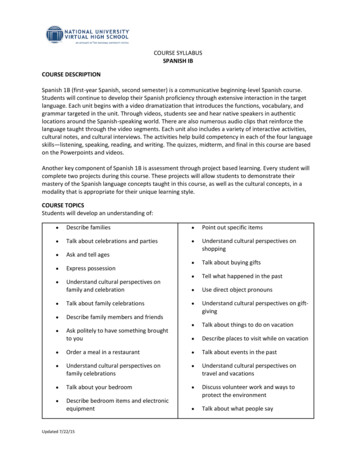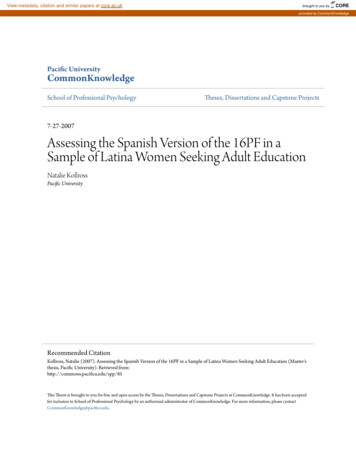
Transcription
View metadata, citation and similar papers at core.ac.ukbrought to you byCOREprovided by CommonKnowledgePacific UniversityCommonKnowledgeSchool of Professional PsychologyTheses, Dissertations and Capstone Projects7-27-2007Assessing the Spanish Version of the 16PF in aSample of Latina Women Seeking Adult EducationNatalie KollrossPacific UniversityRecommended CitationKollross, Natalie (2007). Assessing the Spanish Version of the 16PF in a Sample of Latina Women Seeking Adult Education (Master'sthesis, Pacific University). Retrieved from:http://commons.pacificu.edu/spp/85This Thesis is brought to you for free and open access by the Theses, Dissertations and Capstone Projects at CommonKnowledge. It has been acceptedfor inclusion in School of Professional Psychology by an authorized administrator of CommonKnowledge. For more information, please contactCommonKnowledge@pacificu.edu.
Assessing the Spanish Version of the 16PF in a Sample of Latina WomenSeeking Adult EducationAbstractThis study investigated the comprehensibility of the Spanish version of the 16PF, 4th edition in a sample ofLatina women seeking adult education. The sample consisted of 15 monolingual Spanish-speaking Mexicanwomen living in and around Forest Grove, Oregon. The women provided definitions to a list of words andphrases taken from the Spanish version of the 16PF. Results indicated that not all of the women understoodevery word or phrase as indicated by the meanings provided by each participant. These finding may indicatethat the Spanish version of the 16PF is not appropriate or understood by every Spanish-speaking person.Degree TypeThesisRightsThis work is licensed under a Creative Commons Attribution-Noncommercial-No Derivative Works 3.0License.This thesis is available at CommonKnowledge: http://commons.pacificu.edu/spp/85
Copyright and terms of useIf you have downloaded this document directly from the web or from CommonKnowledge, see the“Rights” section on the previous page for the terms of use.If you have received this document through an interlibrary loan/document delivery service, thefollowing terms of use apply:Copyright in this work is held by the author(s). You may download or print any portion of this documentfor personal use only, or for any use that is allowed by fair use (Title 17, §107 U.S.C.). Except for personalor fair use, you or your borrowing library may not reproduce, remix, republish, post, transmit, ordistribute this document, or any portion thereof, without the permission of the copyright owner. [Note:If this document is licensed under a Creative Commons license (see “Rights” on the previous page)which allows broader usage rights, your use is governed by the terms of that license.]Inquiries regarding further use of these materials should be addressed to: CommonKnowledge Rights,Pacific University Library, 2043 College Way, Forest Grove, OR 97116, (503) 352-7209. Email inquiriesmay be directed to:. copyright@pacificu.eduThis thesis is available at CommonKnowledge: http://commons.pacificu.edu/spp/85
ASSESSING THE SPANISH VERSION OF THE 16PF IN A SAlv1PLE OF LATINAWO:MEN SEEKING ADULT EDUCATIONA THESISSUBlViiTTED TO THE FACULTYOFSCHOOL OF PROFESSIONAL PSYCHOLOGYPACIFIC UNIVERSITYFORESTGROVE, OREGONBYNATALIE KOLLROSSIN PARTIAL FULFILLMENT OF THEREQUIREMENTS FOR THE DEGREEOFMASTER OF SCIENCE IN CLINICAL PSYCHOLOGYJULY 27, 2007VAPPROVED: r- ram"'; B., L e, PhD.
ABSTRACTThis study investigated the comprehensibility of the Spanish version of the 16PF,4thedition in a sample of Latina women seeking adult education. The sample consisted of 15monolingual Spanish-speaking Mexican women living in and around Forest Grove,Oregon. The women provided definitions to a list of words and phrases taken from theSpanish version of the 16PF. Results indicated that not all of the women understoodevery word or phrase as indicated by the meanings provided by each participant. Thesefinding may indicate that the Spanish version of the 16PF is not appropriate orunderstood by every Spanish-speaking person.11.- .----.-.- -- -------. .-- .- -- - .
TABLE OF CONTENTSPageABSTRACT . . . iiACKNOWLEDGEMENTS . . . . . . . . . . . . . . . ivLIST OF TABLES . . . vINTRODUCTION . 1METHOD . . . . . . . . 10RESULTS . . 12DISCUSSION . . . . 15REFERENCES . . . . . . . . .23APPENDIX . . 25111----- - ---.-- - -. -- -- -- . --
ACKNOWLEDGEMENTSThe investigator would like to acknowledge women and administrator from theAdelante Mujeres organization in Forest Grove, Oregon for their patience andpru.ticipation in this thesis project. Without the participation of these women this researchcould not have been accomplished. It was a joy to work with them on this project.I would also like to acknowledge the thesis chair, James Lane, for his advisementand dedication on this project.iv. . - -- ------- ----
LIST OF TABLESFIGURE OF RESULTS . ··· . 14TABLE OF DATA . 25v
INTRODUCTIONThe Spanish-speaking population is fast growing around the world. The Latinominority is now the largest minority in the United States (Chun, Kwon, Williams, & Yu,2005). Many psychological measures have been translated to Spanish, some in severaldifferent Spanish dialects that correspond to a region of the world. For example, there areversions for Latin American dialects. and versions of dialects from Spain. There is a needto verify the validity of these Spanish translations of measures to ensure fair testing forevery population that is tested. Several tests such as the Sixteen Personality FactorQuestionnaire, Myers-Briggs Type Indicator and the Beck Depression Inventory havebeen researched regarding the validity of Spanish equivalents (Cruz Fuentes, Bello,Garcia, Macias, & Chavez Balderas, 2005; Ellis & Mead, 2000; Fuller & Malony, 1984;Levy & Padilla, 1982; Nogales & Hampel, 1977; Whitworth & Perry, 1990; Wiebe &Penley, 2005). Most research points to significant linguistic agreement between Spanishand English versions. Both cultural and linguistic aspects must be considered whenassessing the validity and applicability of the measures. Without considering culturalaspects there is room for error of results. Constructs may not be measured as intendedwhen the sample does not identify culturally with the test or does not understand culturalnuances of the items (Nogales & Hampel, 1977).The Sixteen Personality Factor Questionnaire (16PF) is a psychological test thatmeasures sixteen facets of personality. It looks at bipolar dimensions of normal aspects ofpersonality. It is available in 23 languages, including Spanish (America) and Spanish1
(Castilian). Little literature exists that assess the validity and appropriateness of theSpanish versions of the 16PF. No literature was found regarding whether cultural aspectswere considered or assessed when creating and then utilizing the Spanish version of thetest. No normative data exist on the comprehensibility or readability of the Spanishversion. It has not been tested to verify that the test in comprehensible to people fromvarious Spanish-speaking countries who speak different variations and dialects ofSpanish. The author of the 16 PF, Cattell, makes no claims regarding which Spanishspeaking countries this test is appropriate for. Also, there are no cautions mentioned forusing this test when the comprehensibility has not been studied. In an email query tocustomer service in February of2007, The Institute for Personality and Ability Testingstated that they do not even have infonnation about who translated this test into Spanish.The customer service representative stated that Cattell is the author ofthe Englishtranslation only.The comprehensibility of the English version among various samples has beendemonstrated in research (Buros, 1978; Cattell, 1970, 1976; Cattell, E. P., 2004; Rivera,1996). No research has shown evidence that the comprehension of the Spanish translationof the 16 PF is comparable to the comprehensibility of the English version. It is importantto have a culturally appropriate translation of any test to ensure comprehension and fair,ethical testing and results.Many psychological measures have been translated into Spanish including the16PF, Symptom Check List 90 (SCL-90), Beck Depression Inventory (BDI), MinnesotaMultiphasic Personality Inventory (MMPI), Myers-Briggs Type Indicator, FreiburgPersonality Inventory (FPI), and the Wechsler Intelligence Scale for Children-Revised2iiL .
(WISC-R) (Cruz Fuentes, Bello, Garcia, Macias, & Chavez Balderas, 2005; Ellis &Mead, 2000; Fuller & Malony, 1984; Levy & Padilla, 1982; Nogales & Hampel, 1977;Whitworth & Perry, 1990; Wiebe & Penley, 2005). The present study will consider thetranslation of the 16PF exclusively; however it is important to look at how welltranslations of other measures have faired. One gains a more comprehensive list ofproblems and achievements by reviewing translations that span across the field ofpsychology. One can discover what things are lacking or need further assessment bylooking across the gamut.Cruz Fuentes, Bello, Garcia, Macias, & Chavez Balderas (2005) looked at thevalidity and reliability of the Spanish version of the Symptom Check List 90 (SCL 90).The SCL 90 examines a person' s current level of distress. The authors administered thetest to a sample of228 Spanish speaking Mexican natives and 30 Argentinean natives.Statistical analyses were performed on the data to assess the degree of construct validityand internal consistency. Seven of nine scales were found to have internal consistencywhile 56 of the 90 items showed moderate to high correlations with only one itemshowing a weak correlation (validity). Overall, scores were slightly higher for theMexican sample than the Argentinean sample. The authors concluded that in this sampleadequate internal consistency and validity were shown which may indicate the SCL 90Spanish version being useful clinically and for research. The authors expressed cautionregarding generalizability because of the lack of representation of the Spanish speakingpopulation (a small sample of only Mexicans and Argentineans).Wiebe and Penley (2005) compared the English and Spanish versions of the BeckDepression Inventory (BDI) in a sample of 894 undergraduate college students. They3----- - - - - - ---- - ---- ----------- - - - --
compared factor analyses of scores from the English version and the Spanish version,both of which were completed by the same 355 bilingual participants. No significanteffect for language was found between the bilingual participants' scores on each test.These results are consistent with the cross-language equivalence of the two versions ofthe test.The Spanish versions of the MMPI, the Myers Briggs, and the FPI have beenstudied for their reliability and validity. Fuller and Malony (1984) compared the Englishand Spanish forms of the MMPI with a sample of 18 bilingual adolescent Hispanicwomen. Both versions of the test were administered to each participant and no significantinteraction effects were found between order of administration and form of test. Scoreson five scales were significantly higher for the Spanish version than the English pointingto some possible inequality between the versions. The authors were led to the conclusionthat the Spanish translation of the MMPI could "not be used interchangeably with theEnglish form" (p. 130) and "contest the ready use of the . translation" (p. 131).However, results should be considered carefully due to the small sample size of a veryspecific group of people. For this reason, results are not generalizable to the greaterpopulation. .The results of the Myers-Briggs test faired better. The Spanish translation of theMyers-Briggs Type Indicator Form G, another comprehensive personality measure, wascompared to the English form in a study by Levy and Padilla (1982). The study was apreliminary assessment of the reliability of the development of a Spanish version of thetest. Scores from 65 bilingual Puerto Rican college students on both versions ofthe testwere compared against one another and compared to scores on the English version alone.4-. .- -- .-- ----
The correlation (.79-.89) between the versions taken by the 65 Puerto Rican collegestudents was comparable to the test-retest reliability of the English version (.78-.83).Results indicated that both versions are consistent in a group of bilinguals. However,results are difficult to generalize due to the small sample size. A study on the FPI did notshow such promising results.Nogales and Hampel (1977) compared the Spanish and German versions of theFPI, a German measure of personality, using the original German normative data andnew data analyzed from the Spanish version. The different versions were compared byitem and scale analysis and consideration was taken on how item and content loaded ofcertain variables such as sex and age. The authors determined that in order to fit betterwith a Latino/Hispanic population, the original personality factors needed to becondensed from 9 factors to 5 factors. The results indicate that the original personalityfactors may not be appropriate or understandable to a Spanish-speaking population.Another study (Rodriguez, Torres, Herrans, Rodriguez Aponte, & Llamos, 1994)tested whether the Spanish translation of the WISC-R was appropriate for a sample ofPuerto Ricans. They tested whether participants understood the instructions and if the testwas appropriate for their cognitive level and cultural experience. One hundred six-yearolds from low SES were selected from various schools in Puerto Rico. Participants wereread the instructions and then asked to explain, in their own words, what the instructionswere for each part of the test. Four criteria had to be met to show that a child understoodthe questions. Two criteria had to be met to show the children did not understand. After itwas clear that the children understood, the investigators administered the test. Over 30%of the children did not understand the instructions for two ofthe subtests. The authors5
posited that no inferences can be made about a child's ability on this translated test untilcriteria for comprehension are met. Criteria for two subtests were not met and, thus, thelanguage may need to be modified before the test can justifiably be administered.A study by Whitworth and Perry (1990) looked at the differences between Angloand Mexican Americans on the 16PF. They studied 546 participants in three differentlanguage groups: Anglos that spoke English, Mexican Americans that spoke English andMexican Americans that spoke Spanish. An important finding was that the MexicanAmericans that spoke Spanish had higher scores pointing to negative personality traitsthan the Mexican Americans that spoke English. This indicates a possible bias of theSpanish version leading to more negative outcomes. Although it may be due to culturaldifferences, it points to a possible weakness of the Spanish translation of the 16PF inassessing Spanish speaking populations accurately.Ellis and Mead (2000) also studied the Spanish translation of the 16PF in asample of English speaking Anglo and Hispanic Americans as well as Spanish speakingHispanic Americans and Mexican nationals. The authors used the DifferentialFunctioning ofItems and Tests (DFIT) to examine the equivalence of the Spanish versionin comparison to the English version after administration of both versions. DFITexamines to degree to which the translation differs from the previous version and whetherit is equal to the previous version or if meaning and understanding was lost in translation.There were significant differences in translation found for English versus Spanishversions for all groups and pairings. The largest difference was both Anglo and Hispanic(English speaking) versus the Mexican and Hispanic Spanish speaking. The secondlargest effect was between Anglos and Hispanic English speaking participants.6
Past research has shown that language plays a role in test performance. Researchhas shoWn differences in test scores between Spanish-speaking and English-speakingparticipants on several different psychological measures. Research has found thatbilingual participants score differently when they take the English version of the 16PF ascompared to the Spanish version. These findings stress the importance of having atranslated measure that fairly and validly tests a person's ability or personality traits.These translated measures need to be equal in content and meaning to their Englishcounterparts. A translated measure in Spanish must reflect the language and culture of adiverse population that comes from many different countries and speaks many differentdialects of the language. Thus far, there has been no normalizing research done on thereadability or comprehension of the Spanish version of the 16PF, 4th edition. The presentstudy will intend to begin the research on the readability and comprehensibility of the16PF, 4th edition.This study will investigate how appropriate the translated measure may be formonolingual Spanish speaking female adults of Guatemalan and Mexican descent and. will give the first data on this population for the Spanish translation of the fourth editionof the 16PF. Grammar and psychometric properties are important to test but are beyondthe scope of this study. Qualitative methodology from previous studies (Abrahams, 1999;Wallis & Birt, 2003) was adapted for this study.Abrahams (1999) studied differences in scores on the 16PF between Englishspeaking and Native Afrikaans-spealcing participants. The author wanted to determine theinfluence that native language has on test scores and comprehension. There were 983white, native English-speaking and 81 black, native Afrikaans-speaking psychology7
I- ------------------ -------- -------------------------students in South Africa. The 16PF English version was administered to all participantsand scores were calculated. The qualitative part of the study tested how well eachparticipant understood vocabulary from the test. Participants were asked to providesynonyms to a list of 136 nouns and adjectives taken from the 16PF. significantdifferences were found between groups, with the native English-speakers providing morecorrect synonyms. However, it should be noted that both groups had difficulty providingcorrect synonyms. This problem was corrected for in a replicate study.Wallis and Birt (2003) replicated the study by Abrahams (1999) and changed thescoring procedure for assessing correct synonyms. The authors again studied native andnon-native English-speaking psychology students in South Africa. Participants providedsynonyms to the same list of vocabulary words as in the study by Abrahams. Afterapplying the same methodology they found the same results. However, after adopting lessrigid methodology they found different results. In the more relaxed methodology theauthors used a wider range of dictionaries and thesauruses to identify correct synonymsand allowed participants to use the word in a sentence to show understanding. The nativeEnglish-speakers still provided more correct synonyms. However, both groups correctlyidentified more synonyms than results showed previously, showing that they understoodmore than was thought.The previous studies were testing the English version of the 16PF in native andnon-native English-speaking samples and this study will test the Spanish version in nativeSpanish-speakers only. Also, the previous studies only used a list of vocabulary wordsand this study will include a list of vocabulary words and phrases extracted from theSpanish version of the 16PF. Participants will not be administered the test. They will;81- . . .
provide definitions for the words and phrases. It is hypothesized that the participants willcorrectly define more vocabulary words than phrases for each version of the test, thusproviding evidence that they understand the language overall, but may have missed somecultural nuances found in phrases.9-------------------------- ------------------------- -- -
METHODParticipantsA sample of 40 female native Spanish speakers from the organization, AdelanteMujeres, in Forest Grove, Oregon were selected for the study. Adelante Mujeres,translated as 'forward women,' is an organization that helps native, monolingual Spanishspeaking women gain their General Equivalency Diplomas (GED). Forest Grove is arural town, 30 miles outside of Portland, of over 19, 300 residents and home to PacificUniversity. The participants consisted of females between the ages of20 and 50 and ofMexican and Guatemalan descent.MaterialsThe 16PF-Spanish version is a personality measure that measures 16 normalfactors of personality. The test was originally developed in English and is translated in 23languages. The investigator developed a list of vocabulary words and phrases from the16PF-Spanish version Form A, 4th edition in questionnaire form for the participants todefine. The questionnaire also included two demographic questions: age and country oforiginlethnicity. The questionnaire was adapted from previous studies by Abrahams(1999) and Wallis and Birt (2003).ProcedureThe investigator visited the women in October, 2006 to inform them ofthe studyand ask for their participation. The investigator informed them, briefly, of the study andits purpose and explained that it would take place in April, 2007. Informed consent was10 --- - . ---.-
explained and obtained directly prior to the investigation. All instructions were given inSpanish by the investigator whom is fluent but not a native speaker of Spanish. Theinvestigator administered a questionnaire listing vocabulary words and phrases selectedfrom the 16PF-Spanish version. The participants were instructed to give their owndefinition or meaning for each of the words and phrases. Attached was a separatequestionnaire containing demographic questions of age and ethnicity/country of origin.There was no incentive for participation other than desire to further investigation. Datacollection occurred one time and lasted approximately 30 minutes. It should be noted thatthe investigator worked for the organization in the 2005-2006 academic year and waspreviously acquainted with some of the women. Following the investigation ofparticipants, the investigator checked the definitions given with the help of her clinicalsupervisor, Lucrecia Suarez, a native Spanish speaker.11. -. .- . - -- . -- . -. .- -. -. ---. -.-. - -- - - ---------. - -. -- - . .- ---
RESULTSAfter all definitions were checked by the investigator and then cross-checked by aclinical supervisor it was found that not allIS women gave correct definitions for allwords and phrases. The definitions were deemed correct if they were found in thedictionary or if they conveyed an appropriate meaning, as deemed appropriate by theinvestigator and the supervisor. The majority of women provided concrete examples toconvey their understanding of a word or phrase. For example to describe "segundo plano"or "background" one woman gave the example of a husband who is now in thebackground and ofless importance because there are children-"no Ie tomamosimportancia por ejemplo a un esposo cuando vienen los hijos." Moreover, many womenpersonified each definition, relating it to what a person does or who a person is, ratherthan giving a generic definition. For example, for the word "anticuada" or "antiquated"the participants often said it was when a person dressed from the past or had old thinking"una persona con costumbres de antes" (a person with old ways of doing things).Due to the fact that many of the words or phrases have more than one meaning,many definitions were not indicative of the meanings that were intended in the test. Thiswill be explained further in the discussion section. Words and phrases that were givencorrect definitions but not the intended ones in the 16PF were "vago (vague/vagrant)"pompa (pomp)," "zigzag," "termino medio (in between)," "un segundo plano(background)," and "escribir garabatos (doodle/write illegibly)." The I6PF translationintends the meaning of these words and phrases to be vague, pomp, zigzag, in between,12- -- ---- -------- ------ ---- --
background, and doodle respectively. However, the majority of the participants gavecorrect definitions of vagrant, water pump/posterior, sewing machine mark, unfinished,of less importance or on a different plane of existence, and write illegibly or marks ofchildren, respectively. Out of 600 possible answers, there were 376 correct definitionsgiven, 183 incorrect definitions, and 41 correct definitions that did not contain theintended meaning/understanding on the 16PF test. Figures! represents these numbers.Appendix A contains a list of answers for each participant of each word and phrase andwhether they were 1) correct, 2) incorrect or 3) correct with a different meaning thanintended in the 16PF. There were six words and one phrase that all participants correctlydefined-Iatoso, vanidosa, comites, patr6n, precavido, contrariedades, and obra de caridad.One word and two phrases received mostly correct answers that had a meaning differentfrom that in the test-vago, segundo plano, and escribir garabatos. There was one wordthat no participant provided a correct definition for-tendencioso. It is important to notethat this word was not listed in the Spanish dictionary used for this study. Other phrasesthat most participants failed to give a correct definition for included "observacionesagudas" and "sentido de orientaci6n."13.-.- ------ -- -.- --.--- -- - - .--. -- .-.-. -. ---.--.-- . -.- . --
Figure 1Definitions400350300250Number of Words or 200Phrases15010050o3l Correct 2 lncorrect 3 Correct, but not the test meaning14- - -- - - -- -- - -- - -- -- - - - -- - -- - - - - - . - . . ---- -
DISCUSSIONResearch reviewed earlier in this thesis (Cruz Fuentes, Bello, Garcia, Macias, &Chavez Balderas, 2005; Ellis & Mead, 2000; Fuller & Malony, 1984; Levy & Padilla,1982; Nogales & Hampel, 1977; Whitworth & Perry, 1990; Wiebe & Penley, 2005)demonstrated that Spanish-speaking participants score differently than their Englishspeaking counterparts. It is unknown if these differences occur because of differences inculture or if the translations are not completely understood by the participants and are,therefore, yielding scores that do not accurately portray the individuals. Some of theresearchers compared test performance in groups of bilingual individuals who took thetest in both Spanish and English. They found that the results differed between the twotranslations. This may be explained by a translation that is not accurate or not culturallyappropriate for the sample.Results and ImplicationsThis study was designed to examine whether a group of Mexican immigrantwomen seeking adult education could understand words and phrases taken from theSpanish version of the 16PF. Participants provided definitions of a list of words andphrases to indicate that they understood each meaning. The results indicate that thewomen did not understand all of the words and phrases because no woman providedcorrect definitions for every word and phrase. Also, some definitions given weretechnically correct but did not reflect the same meaning as in the original English versionof the test. This may signify that the women only knew the meaning they gave or it may15
suggest that they know both meanings but only chose to write one meaning. There weresix words and one phrase that all women correctly defined and one word that no womancorrectly defined. The fact that these women incorrectly defined many words and phraseswarns of a flaw in the Spanish translation of the 16PF , 4th edition.Participants were not able to correctly define every word and phrase and thedefinitions given, in totality, were inconsistent for many words and phrases. These resultsclearly show that some Spanish-speaking individuals will misunderstand substantialportions of this test. Such misunderstanding may account for some of the differencesbetween Spanish speakers and English speakers on the 16PF and those among bilingualindividuals on the two versions of the test that has been shown in research.Misunderstanding may cause the results of the 16PF to show an inaccurate personalityprofile because a palticipant endorsed a certain trait or interest, thus scoring in a morepositive or negative direction and rendering the results unusable or inapplicable.It is not understood why the participants did not understand all of the words andphrases. One of the words was misspelled in the original test and was copied the same forthe questionnaire. This may account for some of the participants incorrectly defining theword. However, some participants did show they understood the word. Another possibleexplanation for the lack of understanding may be the translation of the test. As statedpreviously, the translator of the test is unknown, making it difficult
translation of the 16PF exclusively; however it is important to look at how well translations of other measures have faired. One gains a more comprehensive list of problems and achievements by reviewing translations that span across the field of psychology. One can discover what things are lacking or need further assessment by



